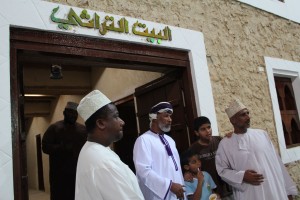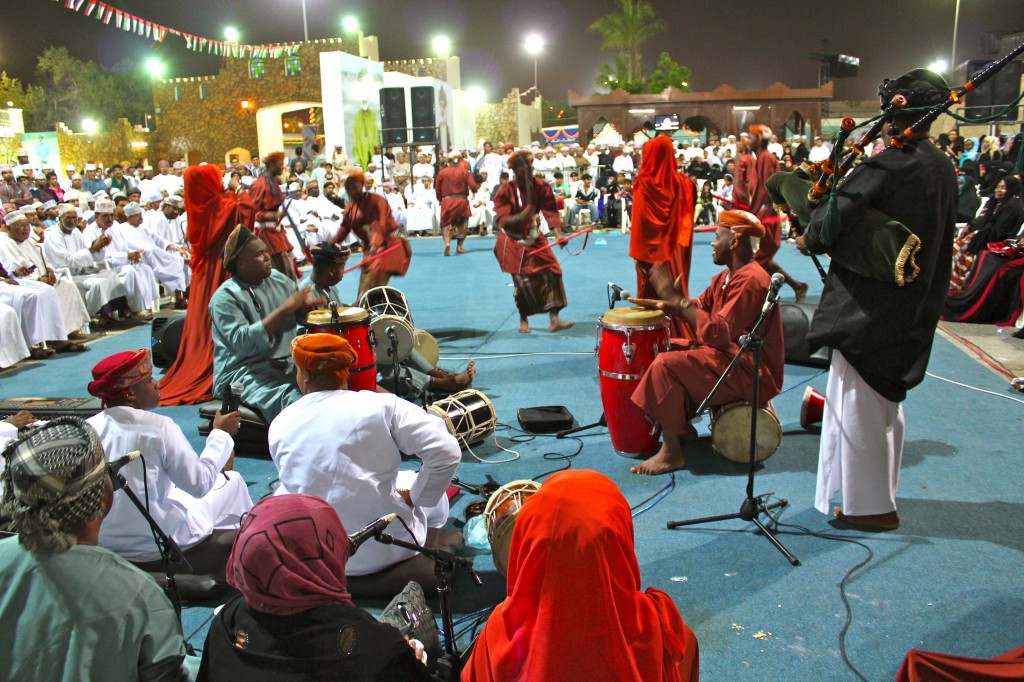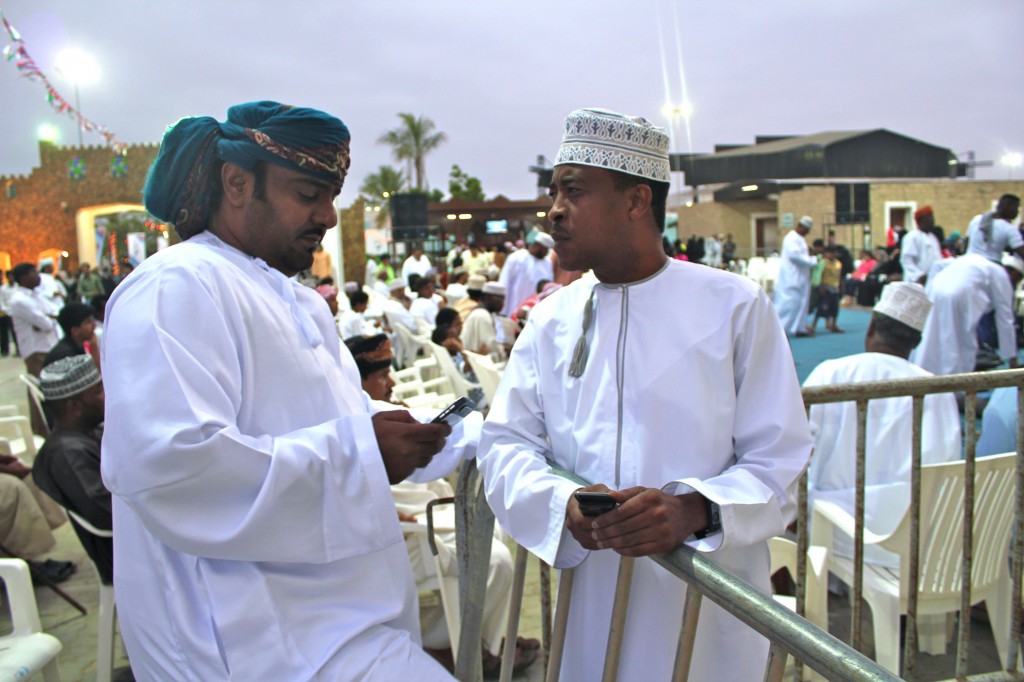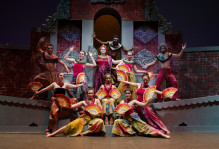3.2. If you see Rabuba you will say: “I love Salalah”!
AKR in OMAN Part 3
2. If you see Rabuba you will say: “I love Salalah”!
This is my fourth evening at the Salalah Tourism Festival also known as the Mahrajan al-Khareef held in the fall (khareef) season when the Salalah and its surroundings on the coasts and in the mountains of the Dhofar region in the South of Oman benefit from the annual Monsoon rains.
I am in the heritage village on the festival site listening to the first of three or four bands (firqa/firaq) that will play this evening at the “Heritage House.” The stage, or rather performance area, is a carpeted rectangle in the open-air plaza of the heritage village at the festival. An area of about 18 ‘ x 40’, the carpet demarking the stage is positioned in front of a traditional house (bait it-turathiya) which also serves as a “green room” for musicians and dancers preparing to set up, or, for those who have just finished their performance. A desk for the soundmen and their equipment is positioned between the house and the stage. Casually arranged rows of white plastic chairs surround the perimeter of the performance area. One side is occupied by women and children, the other side by men, and some children. The chairs are filled to capacity and additional crowds stand behind the seated audience. In short the place is packed.
I have been given a warm welcome to the area every evening by the manager of the events at the “Heritage House Stage,” Said Naseeb Suwielan, an impeccably dressed handsome gentleman who offers me a seat behind the band (where the other band leaders sit) and who has been advising me about which bands to see (“no, don’t go yet, stick around for the next band” or “go on over to the arena now and see so and so”).
Figure 1: Said Suwielan, in dark turban and tassel on his dishdasha, is the manager of the stage in front of the Heritage House.

Figure 1: Said Suwielan, in dark turban and tassel on his dishdasha, is the manager of the stage in front of the Heritage House.
This evening the group Bahajat is-Salalah (the Happiness of Salalah) begins their set with a couple of songs without dance. The musicians and back up singers (some of them also dancers) number about 14: a keyboard player and two singers, 4 male and 7 female back up singers (chorale), 3-4 percussionists playing some combination of the Omani drums kasir and rahmani, along with non-Omani congas, and riqq; a bagpipe player is on hand for the dance “mizmar,” and an extra group of male dancers hang back and wait until it is their time. With the exception of the bagpipe player and of course, the dancers, all musicians sit on the floor on cushions. The first dance they present is Rabuba. Two lines of 6 men and 6 women each weave in and out of one another floating across the carpeted area using deceptively simple steps and elegant choreography. The women’s flowing skirts and veils and the men’s disdashas, uniformly tucked into their belts to reveal their matching and colorful wizars make the dancers appear all the more graceful – like waves on the ocean — I was told by Khamis Raja, my first host in Salalah.
My goal this evening is to enjoy the band and to see if I can identify the handful of distinct music and dance styles that will no doubt be presented. I am largely on my own this evening and I am testing my musical literacy. The Rabuba is followed by Bar‘a, a male dance where an exact number of men – often 4 but sometimes 6 or more – dance holding their daggers (hanjars) high in the air. Bar‘a is the most common of the dances presented by various groups. It is also a social dance. And the last group of the evening at this stage will play Bar‘a for the crowd to dance. When Bar‘a is a social and not a presentational dance, the dancers raise their cell phones above their heads and nod them back and forth in coordinated rhythm. Majid al-Harthy, my colleague from Muscat, was the first to point this out to me last November, at an event he brought me to in Sur, in the Sharkiyya region of Oman. I didn’t think much of it until I saw young guys waving their cell phones at performance after performance in any number of venues. Ethnomusicologists are interested in continuity and change. Here is an example: when necessary, cell phones replace the all-important accessory, the dagger or hanjar for the extremely popular Dhofari dance, the Bar‘a.
Salalah Grooves
The regional music and dance genres, performed by the Salalah groups are distinguished by their rhythmic patterns and grooves. In fact, like jazz or popular musics in the western tradition the same song (melody, lyrics, and song form) can be rendered in more than one musical style, for example as Bar‘a or as Rabuba, just as a jazz standard might be played in a swing, or bop, or Latin groove.
Interlocking patterns between the larger Rahmani and smaller Kasir, double-headed laced drums (often there are three of these in some combination complimented by extra congas, or an Egyptian riqq) distinguish the style. Duple meters, sort of sound like the malfuf pattern of Arabic drumming from the north (Balad ish-Sham), a kind of beguine rhythm of 3+3+2, but with more sophisticated detail than I am ready to try to describe in prose. Rhythmic grooves based in 3, for example the Sharh – which itself has three sub-styles that accelerate in tempo and change in dance style and function are created by the combination of musicians playing patterns in 3 and in 6 simultaneously (3/4 and 6/8). Yet to say simply that the grooves in 3 are redolent with the polyrhythms of 3:2 or 3:4, would a be a complete oversimplification of the aural picture.
The raucous but rock steady percussion section, usually placed at the front or to one side of the ensemble – and not at the back – provide the foundation for the solo singer, and tonight, just a keyboard player, named Abdel Amir, also a music student at the Sultan Qaboos University, who I met earlier in Muscat. The role of the back up singers is huge! Not only do they compliment the soloist’s lines, by singing refrains and joining in on key phrases, they also call out lively shouts of encouragement called tashji‘a (or tashgi‘a), for example the words “YOLA!” and YASI!” in tight, antiphonal call and response. Not only do they paint the sonic tapestry with exciting detail, they physically perform euphoric engagement in the music by bouncing and swaying from their seated positions and by waving their arms in graceful and coordinated motions that proclaim – “we are into it!”
Figure 2: View from behind the band, Bahajat is-Salalah, performing Mizmar in front of the Heritage House. Note the bagpipe player (left), the percussionists at the front of the band, the male and female singers in the foreground of the picture. Two lead singers are in white and a part of the keyboard is in the left of the shot. Male seating area is on the left, female on the right. Male and female dancers prepare for the dance. The men have yet to un-sheath their swords.
Following Bar‘a, this group performs Mizmar, a genre that takes its name from that of the instrument, the double reed “folk-oboe,” mizmar, which has been replaced by the louder and versatile, Scottish highland bagpipes, an instrument whose role in Omani music culture has been aggrandized by its presence in the Sultan’s royal guard. Bagpipes are part of the standard instrumentation of all military music and marching bands and there are perhaps, hundreds of pipers in Oman (and I’ll have more to say on that later but see my earlier posts on the pageants for National Day that I attended in November 2010).
The Mizmar is danced by men and women whose repetitive footwork, again deceptively simple in appearance, propel them around the area in choreographed formations. One distinctive aspect of Mizmar is the swords that the men hold straight up in the air and shake in coordinated unison to make them shimmy and shimmer in the light. These swords, a mandatory accessory of the dance, are no longer real swords but have a light aluminum flexible blade that wiggles and wavers when the men give the hilt or handle a vigorous shake with a snap of the wrist.
The dancers, many of them with now costumes visibly soaked by perspiration, retire to the area behind the band. But now, two more emerge for Sharh, the final dance of performed by Bahajat is-Salalah lasts about 10 minutes. The Sharh, with its three distinct sections starts off in the most moderate tempo of the evening for the “heavy section” later advancing to a faster (sar‘i) section and finally to the section called al-hug, where female dancers replace the men for, what is traditionally, a “dance around the groom.”
Just before the performance this evening, I asked about the quality of the group. A young musician and student at Sultan Qaboos Univeristy, Khalid Mansur, who I also met in Muscat earlier this year, described Bahajat is-Salalah, as “mutawassat” (medium). “Nothing like the Al-Majd, ensemble!,” the professional group led by one of my host’s in Salalah, Khamis Raja. But as I watched Bahajat is-Salalah I found their performance to be electrifying! Their arrangements were tight, the keyboard and bagpipe player were in tune, the singers were dynamic and focused, the audience (men, women, and children), were bopping, swaying, clapping, and waving their hands in the air. Particularly effective were the sections in almost every piece when the otherwise dominant sound of the keyboard (and when used, bagpipe) dropped out and let the rhythm section and singers prevail, making the re-entry of the strident sounds of keyboard synthesizer all the more exciting.
After the performance, Khamis, the keyboard player and university student, and Said, the stylish “manager” of the Heritage House stage indicated in tandem that the group had exceeded their expectations. Their eyebrows raised and their eyes lit up. Yes! They were really good tonight.
Welcome to Salalah!
My welcome to Salalah has been nothing short of extraordinary. My “musical host,” is Rajab Khamis Saad, Designer and Director of Arts Shows and Head of the Arts Section at the Directorate General of Heritage and Culture. His troupe, Al Majd (The Glory) performed on the Washington Mall for the duration of the Smithsonian Festival of Folklife in 2006, and because of a connection through Omani musicologist, Dr. Majid al- Harthy, who was the presenter at the Smithsonian stage, Khamis connected me, even before my arrival, with band leaders, festival producers, his boss, Mr. Muhammad an-Nahari at the Ministry of Culture, and even with musicians to work with one-on-one. Another of my hosts, Khalid Tabook, Head of Reception and Hospitality in the Public Relations Department of the Ministry of Information, came was introduced to me through Khalfan Barwani, another musicologist and with a long involvement in traditional music projects and publications in the Sultanate. Khalid has facilitated the infrastructure of my visit, negotiating an affordable rate on a hotel in this expensive tourist season, a rental car, introductions to directors at the Ministry of Information, and he checks in on me every day for reports on my schedule and any needs I may have. I continue to be inspired and humbled by their reception of me .
Figure 3: Khamis Rajab (right) and Khalid Tabook (left) meeting for the first time at the Salalah Tourism Festival upon my arrival, July 8, 2011, and agreeing on what they will do with and for me. They have just exchanged phone numbers.
On my first evening here in Salalah, Khamis Rajab, a person who has been involved in cultural production since before he graduated from high school, stood by the side of the stage with me as his troupe, Al Majd, performed, providing contextual commentary on the music and dance and filling in the blanks for the questions I had and for those I had not yet even thought of. Of the dance Rabuba, Khamis said:
Look! The leader of this dance is a woman. She can repeat a figure two or three or four times and everyone has to follow her. The night before Rabuba will be performed, the men can barely sleep because they are so excited to dance with the ladies. This dance can go on for four hours or more. And the man has to keep up with the ladies! To drop out would not be acceptable. And he has to know all of their names! Then, Khamis proclaimed:
If you see Rabuba you will say: “I love Salalah!”
Suffice it to say that I have made modest steps in my musical literacy of Salalah! This is due only to the accessibility of music and dance every evening at the festival and beyond [1], and to the openness of the people I have met here who make me feel comfortable and welcome.
I have seen Rabuba and “I love Salalah”!
AKR
[1] Future posts will describe my experience at a private music party or jalsah and the wedding I attended at the invitation of Abdul Hamid, leader of the Bin Taoufiq group, a musical lineage in Salalah that dates back countless generations, and perhaps even to the Middle Ages and early Islamic period.




No comments.
Comments are currently closed. Comments are closed on all posts older than one year, and for those in our archive.